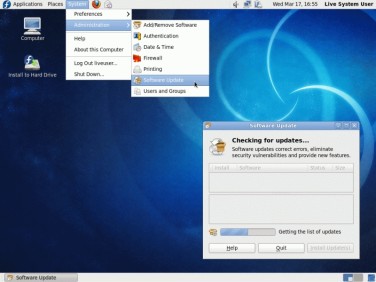This time I've tried a distributive which is very close to the fairy tale Character. No, that is not Red Hat Linux. My first and only (yet) acquittance with Red Hat Linux was 10 years or so ago... Since then Red Hat became fully commercial product for enterprises and no longer supports individuals. But there's an alternative for it. It is also a headgear. This is Fedora. Fedora is actively supported by Red Hat, and acts as playground for new technologies before they are included into main Red Hat package.
My guinea pig was Fedora 13 with GNOME.
Usual process with small adjustment this time. Download iso-image from the Internet. Use Pendrivelinux tool to put it onto the USB drive. Reboot! Choose to boot from USB! Let's go...
Let's do some analysis and compare Fedora to what I actually expect and what I had seen before with other Linux distributives.
- Startup. From the first glance, Fedora does ask you some questions about your location and preferences, like some other distributives do. There is not many questions, but it still takes some time to answer them.
What was a nice surprise for me in the Fedora is that my WiFi card was found immediately. And even more! System automatically scanned WiFi networks around and gave me drop-down list when I clicked the network icon on the panel. So, connecting to WiFi with Fedora is nice and easy as 1-2-3. - Language support. Activating additional language and keyboard in Fedora was also easy process. It is actually not different from any other GNOME-based distributive. Language icon with language codes (Gbr / Rus) appeared on the tool bar very quickly.
- Speed. Running from USB drive, Fedora gives you good impression on the speed. Of course, it is unfair to compare speed of HDD-installed Ubuntu, CD-running OpenSUSE and USB-running Fedora, but I must admit that Fedora works almost as fast from USB as Ubuntu from HDD. Of course, if you compare USB-run SLAX vs USB-run Fedora, there is a difference. But the size of distros is significantly different.
- Software package. Fedora, as usual for big distributives, is well packed with software "out of the box". There are lots of tools which are useful for the user. Starting from Firefox browser (not my favourite Chrome / Chromium though) and to the point of usual tools like disk management. What was a not nice surprise is absence of any kind of Office application in distributive. So, you cannot use Live version to directly work with office documents. Surely you can download OpenOffice.Org software. But that is not "out of the box".
- Saving data. Even though Fedora runs from the USB drive, it still does not allow you to save data. This said, you need to re-choose your location, language and even re-enter the WiFi access code every single boot.

What was my decision? It was pity I had to say bye-bye to Fedora. It is really impressive piece of software! I liked it! As I wrote before, I currently have 4 Operating Systems installed on my laptop: Windows XP, Ubuntu, Kubuntu and Puppy. Even this choice has "one to many" for me, so I don't want to have another system installed. But if the question was which one to choose to add or to replace, then Fedora would definitely be the candidate!
PS. Toshiba laptop with modern WiFi and LAN cards are still not cracked by any distributive. Fedora is next in the list of losers here!
PPS. While I was preparing and wrining this post, Fedora 14 was released. That's fine, let's try it later!


0 comments:
Post a Comment